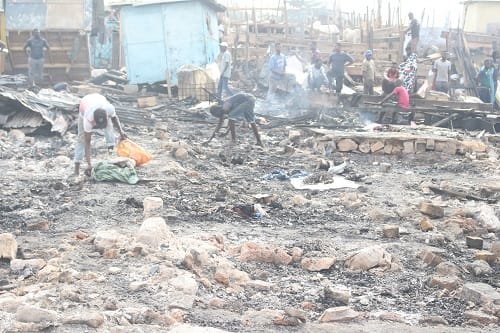[ad_1]
At least 600 people have been displaced following fire outbreak at Avenor market near the Kwame Nkrumah Interchange in Accra, Tuesday dawn.
The inferno also destroyed 450 wooden structures, metal containers used for commercial and domestic purposes.
No casualty was recorded.
When GhanaianTimes got to the scene at about 8:30 am, victims were at the scene salvaging some items left after the damage.
Others were also gathered in small numbers brooding over the misfortune, with others in shock and discussing the tragedy.
Despite the sad situation for many, it was a field day for scrap dealers as they searched through the debris for metals.
Some of the victims who spoke to the Ghanaian Times said they suspected the fire might have been caused by an electrical fault.
A victim identified as Sulley Mogtari said their personal effects and wares had been completely destroyed by the fire and appealed to government to support them.
“We are appealing to government to support the victims of this fire outbreak to help build their structures and bounce back to business,” he added.
The Public Relations Officer of the Accra Regional Fire Command, Assistant Divisional Official Grade I (ADOI) Lewis Kwabena Pagfu, said the Command’s fire fighters were deployed to the scene immediately they received the distress call.
He said fire tenders were deployed from the Kwame Nkrumah Interchange, National Headquarters, Abelemkpe and the Accra Regional headquarters and that the fire was brought under control at 3:21am and extinguish at 4:15am.
ADOI Pagfu stated that the fire engulfed 450 wooden structures and metal containers used for commercial and domestic purposes destroying their content.
He mentioned that unspecified number of vehicles, bicycles, seven houses and 100 wooden structures, a mosque, cattle ranch was saved.
ADOI Pagfu said the main challenges encountered by the firefighters were that there was non-availability of hydrants for replenishing in the area.
The PRO stated that an investigation into the cause of the fire was under investigations.
BY ANITA NYARKO-YIRENKYI
[ad_2]
Source link



